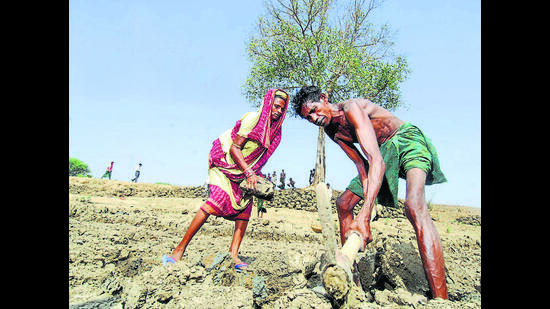What the State must do for the unskilled aged
Better care for the elderly will facilitate the achievement of other SDGs such as those on poverty and health care
The Socio-Economic Caste Census (SECC-2011) had indicated that over 40 million rural households did not have a 25-year-plus literate person in the household. With one-in-five non-literate households and one-in-four landless agricultural labour households, India must look after a generation of non-literate and unskilled wage labourers as they reach old age. Per capita monthly consumption expenditure at under ₹2,000 (2022-23) in the bottom 20% of families also reminds of households that do not get a dignified survival.

With increasing nuclearisation of families even in rural areas, old persons living by themselves on a few days of work under the Mahatma Gandhi National Rural Employment Guarantee Scheme (MGNREGS), free food-grains, and a paltry pension, are not uncommon. Older people reporting for MGNREGS work is also a reality in states like Punjab where market wages are high. All this points to the gaps in our social security system and its ability to secure a life of dignity for the old. With time, this need for care is going to get bigger as ageing with higher life expectancy is a reality.
Support for the elderly needs holistic attention. Access to cashless secondary and tertiary care under the Pradhan Mantri Jan Arogya Yojana (PMJAY) is welcome, but access to free medicines, caregivers, primary and palliative care, among others, continue to be a challenge. Effective coverage under PMJAY requires last-mile facilitation through community workers and caregivers as mere enrolment is no guarantee of free cashless service. Old-age pension is a part of the National Social Assistance Programme (NSAP). But, at ₹200- ₹500, the support has remained extremely modest. If states did not provide additional support from their own budgets, the NSAP support would mean little to an old and vulnerable household. Being delinked from the Consumer Price Index, there are no periodic upward revisions. It is time for the Union and state governments to have a dialogue on a living wage support for the elderly in need. Participatory identification of the genuine elderly in need of care by involving women’s collectives and local governments may be the best approach to identification.
Skilling agricultural labourers works well in a slightly lower age group where a person has many productive working years ahead. For those who have already reached 60 or very nearly there, the option of contributory pension schemes like Atal Pension Yojana is not there. A generation of non-literate, unskilled, ageing families need support from the State and civil society. Experiments with self-help groups of the elderly by the National Rural Livelihood Mission or by HelpAge India have been very effective, and it is time to focus on them. The 100 million women in 10 million women’s collectives are an excellent example of social capital leading to diversification of livelihoods on scale. It is time a similar movement for elderly care is built around their social capital with civil society and corporate social responsibility supplementing the efforts of a caring, convergent State. Elderly collectives with community caregivers are the answer for sustainable geriatric care.
Women’s collectives have attracted the attention of all political parties in the states as they are also seen as active voters whose numbers make a difference. With time, the constituency of 60-plus non-literate, unskilled wanting lives of dignity is going to grow. They too will become an influential group like farmers and women. The elderly need urgent holistic support. They are already in large numbers in states like Kerala and Tamil Nadu with lower fertility rates and high life expectancy for some decades.
While elderly care does not constitute a separate Sustainable Development Goal (SDG), better care for the elderly will facilitate the achievement of other SDGs such as those on poverty and health care. The Pradhan Mantri Awas Yojana Gramin has given some dignity to the old, especially women as homeowners. Given the nuclearisation of households, we need to address the challenge of support for the vulnerable elderly.
The urban areas throw up their own challenges in connecting households to public services. Public spaces for social and cultural engagement become very important in the context of the elderly. While some support through old-age homes and elderly care centres is there, given the growing size of the elderly and vulnerable, we will have to scale up our level of operations to be really a caring society. Local governments with flexible resources for community-based care are the way forward.
Support for the elderly cannot be through centralised vertical initiatives. They must figure high in the work agendas of Accredited Social Health Activists (ASHAs) and the Community Resource Persons under the National Rural Livelihood Mission. Mobilisation of the elderly through elderly self-help groups or associations and facilitation of their social activities, with access to civil society support, can go a long way in improving the lives of those in need.
Amarjeet Sinha is senior fellow, Centre for Social and Economic Progress. He is also on the governing board of HelpAge India. The views expressed are personal
All Access.
One Subscription.
Get 360° coverage—from daily headlines
to 100 year archives.



HT App & Website






